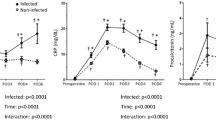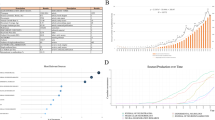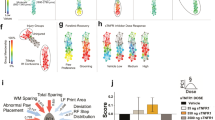Abstract
Study design:
Prospective, nonrandomized, observational cohort study.
Objectives:
To analyze procalcitonin (PCT) level in acute traumatic spinal cord injury patients with and without postoperative infectious complications, and to determine whether PCT is a prognostic parameter of infectious complications in the early postoperative period compared with other inflammatory markers.
Setting:
Spine center of Chongqing, China; Trauma center of Chinese People's Liberation Army, China.
Methods:
A total of 339 consecutive patients with acute spinal cord injury undergone surgery were evaluated. All patients underwent measurement of leukocyte count, erythrocyte sedimentation rate (ESR), C-reactive protein (CRP), and serum PCT preoperatively and 24–48 h postoperatively.
Results:
In all, 26 (7.7%) of 339 participants experienced postoperative infectious complication. Patients with infection exhibited significantly higher PCT and CRP levels compared with noninfection (both P<0.01). Multivariate logistic regression analysis showed that PCT and CRP levels were independent predicators for postoperative infection. The area under the receiver operating characteristics curve of PCT and CRP were 0.82 (95% confidence intervals (CI) 0.74–0.91) and 0.68 (95%CI, 0.57–0.78), respectively. A PCT cutoff of 0.1 ng ml−1 had a reasonable sensitivity of 92% to exclude an infection and antibiotics can be initially withheld. However, in patients with PCT level above 0.5 ng ml−1, a rapid initiation of antibiotics may be warranted.
Conclusions:
Serum PCT is a more reliable biologic marker for the early prediction of postoperative infectious complications in patients with acute traumatic spinal cord injury compared with CRP. PCT can early identify postoperative infections for establishing effective antibiotic therapy.
Similar content being viewed by others
Log in or create a free account to read this content
Gain free access to this article, as well as selected content from this journal and more on nature.com
or
References
Fang A, Hu SS, Endres N, Bradford DS . Risk factors for infection after spinal surgery. Spine 2005; 30: 1460–1465.
Pull ter Gunne AF, van Laarhoven CJ, Cohen DB . Incidence of surgical site infection following adult spinal deformity surgery: an analysis of patient risk. Eur Spine J 2010; 19: 982–988.
Schroeder S, Hochreiter M, Koehler T, Schweiger AM, Bein B, Keck FS et al. Procalcitonin (PCT)-guided algorithm reduces length of antibiotic treatment in surgical intensive care patients with severe sepsis: results of a prospective randomized study. Langenbecks Arch Surg 2009; 394: 221–226.
Black S, Kushner I, Samols D . C-reactive Protein. J Biol Chem 2004; 279: 48487–48490.
Assicot M, Gendrel D, Carsin H, Raymond J, Guilbaud J, Bohuon C . High serum procalcitonin concentrations in patients with sepsis and infection. Lancet 1993; 341: 515–518.
Muller F, Christ-Crain M, Bregenzer T, Krause M, Zimmerli W, Mueller B et al. Procalcitonin levels predict bacteremia in patients with community-acquired pneumonia: a prospective cohort trial. Chest 2010; 138: 121–129.
Fioretto JR, Martin JG, Kurokawa CS, Carpi MF, Bonatto RC, de Moraes MA et al. Comparison between procalcitonin and C-reactive protein for early diagnosis of children with sepsis or septic shock. Inflamm Res 2010; 59: 581–586.
Hunziker S, Hugle T, Schuchardt K, Groeschl I, Schuetz P, Mueller B et al. The value of serum procalcitonin level for differentiation of infectious from noninfectious causes of fever after orthopaedic surgery. J Bone Joint Surg Am 2010; 92: 138–148.
Takahashi J, Ebara S, Kamimura M, Kinoshita T, Itoh H, Yuzawa Y et al. Early-phase enhanced inflammatory reaction after spinal instrumentation surgery. Spine 2001; 26: 1698–1704.
Worthington T, Dunlop D, Casey A, Lambert R, Luscombe J, Elliott T . Serum procalcitonin, interleukin-6, soluble intercellular adhesin molecule-1 and IgG to short-chain exocellular lipoteichoic acid as predictors of infection in total joint prosthesis revision. Br J Biomed Sci 2010; 67: 71–76.
Castelli GP, Pognani C, Cita M, Paladini R . Procalcitonin as a prognostic and diagnostic tool for septic complications after major trauma. Crit Care Med 2009; 37: 1845–1849.
Ksycki MF, Namias N . Nosocomial urinary tract infection. Surg Clin North Am 2009; 89: 475–481, ix-x.
Morrow LE, Kollef MH . Recognition and prevention of nosocomial pneumonia in the intensive care unit and infection control in mechanical ventilation. Crit Care Med 2010; 38 (8 Suppl): S352–S362.
Mok JM, Guillaume TJ, Talu U, Berven SH, Deviren V, Kroeber M et al. Clinical outcome of deep wound infection after instrumented posterior spinal fusion: a matched cohort analysis. Spine 2009; 34: 578–583.
Emori TG, Culver DH, Horan TC, Jarvis WR, White JW, Olson DR et al. National nosocomial infections surveillance system (NNIS): description of surveillance methods. Am J Infect Control 1991; 19: 19–35.
Garner JS, Jarvis WR, Emori TG, Horan TC, Hughes JM . CDC definitions for nosocomial infections, 1988. Am J Infect Control 1988; 16: 128–140.
Simon L, Gauvin F, Amre DK, Saint-Louis P, Lacroix J . Serum procalcitonin and C-reactive protein levels as markers of bacterial infection: a systematic review and meta-analysis. Clin Infect Dis 2004; 39: 206–217.
Bargues L, Chancerelle Y, Catineau J, Jault P, Carsin H . Evaluation of serum procalcitonin concentration in the ICU following severe burn. Burns 2007; 33: 860–864.
Wimmer C, Gluch H, Franzreb M, Ogon M . Predisposing factors for infection in spine surgery: a survey of 850 spinal procedures. J Spinal Disord 1998; 11: 124–128.
Rau B, Steinbach G, Gansauge F, Mayer JM, Grunert A, Beger HG . The potential role of procalcitonin and interleukin 8 in the prediction of infected necrosis in acute pancreatitis. Gut 1997; 41: 832–840.
Khan MH, Smith PN, Rao N, Donaldson WF . Serum C-reactive protein levels correlate with clinical response in patients treated with antibiotics for wound infections after spinal surgery. Spine J 2006; 6: 311–315.
Bouadma L, Luyt CE, Tubach F, Cracco C, Alvarez A, Schwebel C et al. Use of procalcitonin to reduce patients′ exposure to antibiotics in intensive care units (PRORATA trial): a multicentre randomised controlled trial. Lancet 2010; 375: 463–474.
Kopterides P, Siempos II, Tsangaris I, Tsantes A, Armaganidis A . Procalcitonin-guided algorithms of antibiotic therapy in the intensive care unit: a systematic review and meta-analysis of randomized controlled trials. Crit Care Med 2010; 38: 2229–2241.
Daniels JM, Schoorl M, Snijders D, Knol DL, Lutter R, Jansen HM et al. Procalcitonin vs C-reactive protein as predictive markers of response to antibiotic therapy in acute exacerbations of COPD. Chest 2010; 138: 1108–1115.
Pavcnik-Arnol M, Bonac B, Groselj-Grenc M, Derganc M . Changes in serum procalcitonin, interleukin 6, interleukin 8 and C-reactive protein in neonates after surgery. Eur J Pediatr Surg 2010; 20: 262–266.
Mok JM, Pekmezci M, Piper SL, Boyd E, Berven SH, Burch S et al. Use of C-reactive protein after spinal surgery: comparison with erythrocyte sedimentation rate as predictor of early postoperative infectious complications. Spine 2008; 33: 415–421.
Welsch T, Muller SA, Ulrich A, Kischlat A, Hinz U, Kienle P et al. C-reactive protein as early predictor for infectious postoperative complications in rectal surgery. Int J Colorectal Dis 2007; 22: 1499–1507.
Kotoula A, Gardikis S, Tsalkidis A, Mantadakis E, Zissimopoulos A, Deftereos S et al. Comparative efficacies of procalcitonin and conventional inflammatory markers for prediction of renal parenchymal inflammation in pediatric first urinary tract infection. Urology 2009; 73: 782–786.
Holm A, Pedersen SS, Nexoe J, Obel N, Nielsen LP, Koldkjaer O et al. Procalcitonin versus C-reactive protein for predicting pneumonia in adults with lower respiratory tract infection in primary care. Br J Gen Pract 2007; 57: 555–560.
Carboni GL, Fahrner R, Gazdhar A, Printzen G, Schmid RA, Hoksch B . Comparison of procalcitonin and CrP in the postoperative course after lung decortication. Eur J Cardiothorac Surg 2008; 33: 777–780.
Acknowledgements
We thank the staff and patients from Chongqing Spine Center, Trauma Center of Chinese People’s Liberation Army, for their contributions and participation in this study.
Author information
Authors and Affiliations
Corresponding author
Ethics declarations
Competing interests
The authors declare no conflict of interest.
Rights and permissions
About this article
Cite this article
Nie, H., Jiang, D., Ou, Y. et al. Procalcitonin as an early predictor of postoperative infectious complications in patients with acute traumatic spinal cord injury. Spinal Cord 49, 715–720 (2011). https://doi.org/10.1038/sc.2010.190
Received:
Revised:
Accepted:
Published:
Issue date:
DOI: https://doi.org/10.1038/sc.2010.190
Keywords
This article is cited by
-
A prospective study to identify preoperative serum parameters for spinal implant infection detected by sonication fluid culture
European Spine Journal (2023)
-
The role of procalcitonin in reducing antibiotics across the surgical pathway
World Journal of Emergency Surgery (2021)
-
Usefulness of inflammatory markers and clinical manifestation for an earlier method to diagnosis surgical site infection after spinal surgery
International Orthopaedics (2020)
-
Searching for predictors of surgical complications in critically ill surgery patients in the intensive care unit: a review
Surgery Today (2015)
-
Revision Surgery for Failed Cervical Spine Reconstruction
HSS Journal ® (2015)



